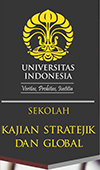Bahasa Abstract
Menurut Global Terrorism Index dan Global Terrorism Database, kondisi terorisme Indonesia pada 2019 membaik dibanding tahun sebelumnya. Memang aksi teror seperti bom bunuh diri di Sibolga dan penyerangan terhadap Menkopolhukam Wiranto terjadi pada 2019, tetapi aksi-aksi tersebut tidak inovatif secara taktik dan tidak letal secara dampak. Indonesia pernah mengalami aksi teror dengan taktik serupa yang jauh lebih mematikan, seperti Bom Bali 1 pada 2002 dan pengeboman terhadap Duta Besar Filipina pada 2000. Tidak berkembangnya serangan teror di Indonesia tidak dapat dilepaskan dari kebijakan negara, yang baik secara langsung maupun tidak langsung telah turut membuat berbagai pihak ikut sadar akan pentingnya sistem keamanan menghadapi terorisme. Tulisan ini berusaha melihat bagaimana peran sistem keamanan dalam mencegah aksi terorisme. Tulisan ini berfokus pada analisis atas data-data sekunder untuk menjelaskan bagaimana kaitan sistem keamanan terhadap pencegahan terorisme. Berdasarkan sumber-sumber yang ditinjau, didapati bahwa sistem keamanan berperan dalam pencegahan terorisme pada dua hal. Pertama, ia membuat serangan terorisme terhadap target strategis yang diberi pengamanan menjadi lebih sulit dilakukan. Kedua, ia membuat terorisme menjadi tidak efektif, karena serangan terhadap target strategis berpengamanan tinggi yang dialihkan kepada target-target mudah (soft target) ternyata tidak membuat para teroris menjadi lebih dekat dengan tujuan akhir mereka.
References
Buku
Bennett, B. T. (2006). Understanding, Assessing, and Responding to Terrorism: Protecting Critical Infrastructure and Personnel (2nd ed.). New Jersey: John Wiley & Sons, Inc.
Buzan, B. (1991). People, States, and Fear: An Agenda for Security Analysis in the Post-Cold War Era. Birghton: Weatsheaf.
Conboy, K. (2008). Medan Tempur Kedua: Kisah Panjang yang Berujung pada Bom Bali II. Tangerang Selatan: Pustaka Primatama.
Drake, C. J. (1998). Terrorists' Target Selection. New York: St. Martin's Press, Inc.
Pape, R. A. (2005). Dying to Win: The Strategic Logic of Suicide Terrorism. New York: Random House.
Soufan, A. (2017). Anatomy of Terror: From the Death of Bin Laden to the Rise of the Islamic State. New York: W. W. Norton & Company.
UNODC. (2016). Handbook on Dynamic Security and Prison Intelligence. New York: United Nation.
Bab Buku
Hsu, H. Y., & Newman, G. R. (2016). The Situational Approach to Terrorism. In G. LaFree, & J. D. Freilich, The Handbook of the Criminology of Terrorism (pp. 150-161). Massachusetts: Wiley Blackwell.
Johnson, S.D., Guerette, R.T., & Bowers, K.J. (2012). Crime Displacement and Diffusion of Benefit. Dalam Farrington, D.P. & Welsh, B.C, The Oxford Handbook of Crime Prevention (pp. 337-353). Oxford: Oxford University Pres.
Rapoport, D. C. (2016). The Four Waves of Modern Terrorism. Dalam S. M. Chermak, & J. D. Freilich, Transnational Terrorism (pp. 3-30). New York: Routledge.
Artikel Jurnal
Abrahms, M. (2006). Why Terrorism Does Not Work. International Security, 31(2), 42-78.
Ahmed, R. (2018). Terrorist Ideologies and Target Selection. Journal of Applied Security Research, 13(3), 376-390.
Asal, V., & Rethemeyer, R. K. (2008). The Nature of the Beast: Organizational Structures and Lethality of Terrorist Attacks. The Journal of Politics, 70(2), 437-449.
Asal, V., Gill, P., Rethemeyer, R. K., & Horgan, J. (2015). Killing Range: Explaining Lethality Variance within a Terrorist Organization. Journal of Conflict Resolution, 59(3), 401-427.
Barr, R., & Pease, K. (1990). Crime Placement, Displacement, and Deflection. Crime and Justice, 12, 277-318.
Clarke, R. V. (1995). Situational Crime Prevention. Crime and Justice, 19, 91-150.
Drake, C. (1998). The Role of Ideology in Terrorists' Target Selection. Terrorism and Political Violence, 10(2), 53-85.
Freilich, J. D., Gruenewald, J., & Mandala, M. (2018, October). Situational Crime Prevention and Terrorism: An Assessment of 10 Years of Research. Criminal Justice Policy Review, 00(0), 1-29.
Gruber, R. (Tanpa tahun). Perimeter Security: Deter, Detect, Delay, and Deny. Master Halco, 1-8. Retrieved from https://www.plantservices.com/assets/wp_downlo ads/pdf/master_halco_deter_detect_delay_deny_ wp.pdf
Hemmingby, C. (2017). Exploring the Continuum of Lethality: Militant Islamists’ Targeting Preferences in Europe. Perspectives on Terrorism, 11(5), 25-41.
Horowitz, M. C. (2015). The Rise and Spread of Suicide Bombing. Annual Review of Political Science, 18, 69-84.
Hou, D., Gaibulloev, K., & Sandler, T. (2020). Introducing Extended Data on Terrorist Groups (EDTG), 1970 to 2016. Journal of Conflict Resolution, 64(1), 199-225.
Hsu, H.Y., & McDowell, D. (2017). Does Targethardening Result in Deadlier Terrorist Attacks against Protected Targets? An Examination of Unintended Harmful Consequences.
Hwang, C. J. (2012). Terrorism in Perspective: An Assessment of ‘Jihad Project’ Trends in Indonesia. Analysis from the East-West Center, 104.
Kruglanski, A. W., & Gelfand, M. J. (2013, March 29). Motivation, Ideology, and the Social Process in Radicalization. APS Observer, 26(4). Retrieved from https://www.psychologicalscience.org/observer/motivation-ideology-and-the-social-process-in-radicalization
Madsen, J. (2004). Suicide Terrorism: Rationalizing the Irrational. Strategic Insights, III(8).
Nilsson, M. (2015). Hard and soft targets: the lethality of suicide terrorism. Journal of International Relations and Development, 1-17.
Piazza, J. A. (2009). Is Islamist Terrorism More Dangerous?: An Empirical Study of Group Ideology, Organization, and Goal Structure. Terrorism and Political Violence, 21, 62-88.
Wikström, P.-O. H. (2014). Why Crime Happens: A Situational Action Theory. In G. Manzo, Analytical Sociology: Actions and Networks (pp. 72-94). New Jersey: John Wiley & Sons, Ltd.
Laporan
Institute for Economics and Peace. (2020). Global Terrorism Index 2020: Meassuring the Impact of Terrorism. Sydney: IEP.
Lai, E.R. (2011). Motivation: A Literature Review. Pearson Research Report.
START. (2020). Global Terrorism Overview: Terrorism in 2019. Maryland: START.
Website
CNN Indonesia. (2019, November 20). 257 Orang Dicap Tersangka Teroris Sepanjang 2019. Retrieved April 4, 2021, from cnnindonesia.com: https://www.cnnindonesia.com/nasional/20191120114933-12-449923/257-orang-dicap-tersangka-teroris-sepanjang-2019
Kompas.com. (2019, Desember 12). 4 Fakta Terbaru Penusukan Wiranto, Gunakan Senjata Kunai hingga Usus Halus Dipotong 40 Cm. (Rachmawati, Editor) Retrieved April 4, 2021, from kompas.com: https://regional.kompas.com/read/2019/10/12/06360081/4-fakta-terbaru-penusukan-wiranto-gunakan-senjata-kunai-hingga-usus-halus?page=all
Recommended Citation
Maulana, Iwa
(2021)
"TELAAH ATAS PERAN SISTEM KEAMANAN DALAM PENCEGAHAN SERANGAN TERORISME,"
Journal of Terrorism Studies: Vol. 3:
No.
1, Article 4.
DOI: 10.7454/jts.v3i1.1031
Available at:
https://scholarhub.ui.ac.id/jts/vol3/iss1/4


